Leicester: Difference between revisions
m clean up, typos fixed: villges → villages, , → , |
|||
| Line 143: | Line 143: | ||
*{{cite web|url=http://www.leicester.gov.uk/ |title=Leicester City Council}} | *{{cite web|url=http://www.leicester.gov.uk/ |title=Leicester City Council}} | ||
*{{cite web|url=http://www.arthurlloyd.co.uk/LeicesterTheatresIndex.htm |title=Leicester's Theatre History}} | *{{cite web|url=http://www.arthurlloyd.co.uk/LeicesterTheatresIndex.htm |title=Leicester's Theatre History}} | ||
{{Cities in the United Kingdom}} | |||
Latest revision as of 10:50, 30 March 2016
| Leicester | |
| Leicestershire | |
|---|---|
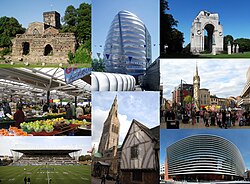 Leicester scenes | |
| Location | |
| Grid reference: | SK585045 |
| Location: | 52°38’6"N, 1°8’13"W |
| Data | |
| Postcode: | LE |
| Dialling code: | 0116 |
| Local Government | |
| Council: | Leicester |
| Parliamentary constituency: |
Leicester South Leicester West Leicester East |
Leicester is a city in the heart of Leicestershire, of which it is the county town. It is major Midlands city, rooted in ancient history but also in industrial endeavour, its many ages making their mark on today’s city.
Leicester stands on the River Soar, and on the coal fields of Leicestershire. It is at the edge of the National Forest.
Ancient Roman pavements and baths remain in Leicester from its early settlement as Ratae Corieltauvorum. Later it rose as an Anglo-Saxon town and when it was captured by the Danes it became one of five fortified towns important to the Danelaw.
Industrial growth in the 19th century transformed Leicester and it became a major economic centre with a variety of manufacturers engaged in engineering, shoemaking and hosiery production. The economic success of these industries, and businesses ancillary to them resulted in significant urban expansion into the surrounding countryside. The city expanded throughout the 19th and 20th centuries, absorbing the villages about it. It was granted city status in 1919. It became a cathedral city in 1927.
The city has a large ethnic minority population, particularly of South Asian origin, a product of immigration to the United Kingdom since the Second World War. To cater for the South Asian community, there are many Hindu, Sikh and Muslim places of worship and the Melton Road district serves as a focus, containing large numbers of Asian restaurants and other small businesses. Leicester is a centre for higher education, with both Leicester University and De Montfort University being based in the city.
Name of the city
The first name we have for Leicester is the Romans' name: Ratae Corieltauvorum, from the local Corietauvi tribe. The name of Leicester comes down to us from the Old English Ligoraceastre or Lægreceastre, which may come from “city on the Ligore", perhaps an early name for the River Soar or more as it is commonly derived "City of the Legions".
Leicester appears in the Domesday Book as "Ledecestre". Leicester continued to grow throughout the Early Modern period as a market town, although it was the Industrial Revolution that facilitated an unparalleled process of unplanned urbanisation in the area.
History
Roman
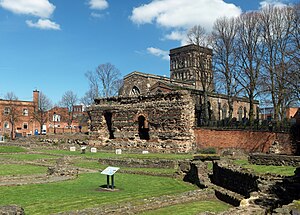
Leicester is one of the oldest cities in England, with a history going back at least 2,000 years. The first recorded name of the city is the Roman label Ratae Corieltauvorum. Before being settled by Romans it was the capital of the Corieltauvi tribe, who ruled over the eastern Midlands.
Ratae Corieltauvorum was founded around AD 50 as a military settlement along the Fosse Way, a Roman road. After the military departure, Ratae Corieltauvorum grew into an important trading centre and one of the largest towns in Roman Britain. The remains of the baths of Roman Leicester can be seen at the Jewry Wall and other Roman artefacts are displayed in the Jewry Wall Museum adjacent to the site.
Anglo-Saxon and Danish history
Knowledge of the town in the 5th century is very patchy. Certainly there is some continuation of occupation of the town, though on a much reduced scale in the 5th and 6th centuries. The area became a town of the Middle Angles whose territory was subsequently absorbed into the kingdom of the Mercians. Leicester was chosen as the centre of a bishopric (and therefore a city) in 679/80 which survived until the 9th century, when Leicester was captured by the Danes and became one of the “five boroughs” (fortified towns) of the Danelaw, although this position was short lived. The English Bishop of Leicester fled to Dorchester-on-Thames and Leicester was not to become a bishopric again until the 20th century.
The Danes of Leicester surrendered peacefully to Ǽthelflæd, Lady odf the Mercians, and King Alfred’s daughter, in 918. The Five Boroughs were recaptured by the Norwegians of Northumbria at the beginning of King Edmund’s reign, but soon recovered. References in the Chronicle and in law codes suggest that the danes were left in peace with their own laws and continued to contribute to the prosperity of Leicester.
Middlel Ages
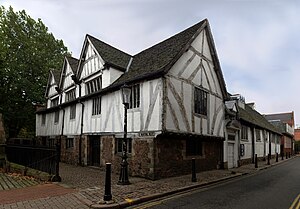
Leicester became a town of considerable importance by the Middle Ages. It was mentioned in the Domesday Book as 'civitas' (city), but it was recognised formally as a city only in 1919. The Church of St Martin became Cathedral in 1927. The tomb of King Richard III is located in the central nave of the cathedral although he is not actually buried there. He was originally buried in the Greyfriars Church]] in Leicester, but there is a legend that his corpse was exhumed under orders from Henry VII and cast into the River Soar, although there is no evidence for this and some historians believe that his tomb and bones were destroyed with the dissolution of the monastery.
The town is mentioned in Geoffrey of Monmouth's Historia Regum Britanniae, written around 1136. According to Monmouth's pseudohistorical work, much regarded in its time though not in a sober age, a mythical king of the Britons, King Leir, founded the city of Kaerleir ('Leir's chester'). Today the name of the city in the Welsh language is Caerlŷr. Leir was supposedly buried by Queen Cordelia in a chamber beneath the River Soar near the city dedicated to the Roman god Janus, and every year people celebrated his feast-day near Leir's tomb.[1] William Shakespeare's King Lear is loosely based on this story and there is a statue of Lear in Watermead Country Park.
Leicester played a significant role in the history of England, when, in 1265, Simon de Montfort forced King Henry III to hold the first Parliament of England at the now-ruined Leicester Castle. This was not the only time parliament was held in Leicester; the Parliament met in the Castle here in 1426, an assembly known as the "Parliament of Bats", for the weapons carried by the members, who were forbidden to bear swords.
Tudor Leicester

On 4 November 1530, Cardinal Thomas Wolsey was arrested on charges of treason and taken from York Place. On his way south to face trial at the Tower of London, he fell ill. The group escorting him was concerned enough to stop at Leicester. There, Wolsey's condition quickly worsened and he died on 29 November 1530 and was buried at Leicester Abbey, now Abbey Park.
Lady Jane Grey, (1536/7 — 12 February 1554), a great-granddaughter of Henry VII, reigned as uncrowned Queen Regnant of England for nine days in July 1553, and for that reason is called "The Nine Days Queen" was born at Bradgate Park near Leicester.
Queen Elizabeth I's personal favoured courtier, Robert Dudley, whom the Queen had considered marrying, was given the Earldom of Leicester.
Civil War
Leicester was a Parliamentarian stronghold during the English Civil War. In 1645, Prince Rupert decided to attack the city to draw the New Model Army away from the Royalist headquarters of Oxford.
Royalist guns were set up on Raw Dykes and after an unsatisfactory response to a demand for surrender, the Newarke was stormed and the city was sacked on 30 May. Although hundreds of people were killed by Rupert's cavalry, reports of the severity of the sacking were exaggerated by the Parliamentary press in London.[2]
18th and 19th centuries

The construction of the Grand Union Canal in the 1790s linked Leicester to London and Birmingham and by 1832 the railway had arrived in Leicester; the new Leicester and Swannington Railway providing a supply of coal to the town from nearby collieries. By 1840 the Midland Counties Railway had linked Leicester to the national railway network and by the 1860s, Leicester had gained a direct rail link to London (St Pancras) with the completion of the Midland Main Line.
These developments in transport encouraged and accompanied a process of industrialisation which intensified throughout the reign of Queen Victoria (1837–1901). Factories began to appear, particularly along the canal and the River Soar. Between 1861 and 1901 Leicester's population increased from 68,000 to 212,000 and the proportion employed in trade, commerce, building and the city's new factories and workshops rose steadily. Hosiery, textiles and footwear became major industrial employers joined, in the latter part of the century, by engineering.
During this period a number of what were to become substantial Engineering business were established these included Taylor & Hubbard Ltd, Kent Street, Leicester (Crane Makers, Founders), William Gimson and Company, Vulcan Road (Steam Boilers, Founders), Richards & Co, Martin Street(Founders, Structural Steel workers).
Years of consistent economic growth meant that, for many, living standards increased. The second half of the 19th century also witnessed the creation of many public institutions that we now take for granted such as the town council, the Royal Infirmary and the Leicester Constabulary and the acceptance that municipal organisations had a responsibility for water supply, drainage and sanitation.
The borough expanded throughout the 19th century, most notably in 1892 annexing Belgrave, Aylestone, North Evington, Knighton and the rapidly expanding residential suburb of Stoneygate, home to many of the city's wealthier families and some of its growing middle class. Leicester became a county borough in 1889, a status lost in 1974.
Early 20th century
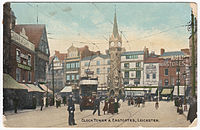
Leicester was formally recognised as a city in 1919 and a cathedral city on the consecration of St Martin's in 1927. It obtained its current boundaries in 1935, with the annexation of the remainder of Evington, Humberstone, Beaumont Leys and part of Braunstone. In 1900 an important new transport link, the Great Central Railway provided a new goods and passenger route to London.
By the time of Queen Victoria's death in 1901 the rapid population growth of the previous decades had already began to slow and the Great War of 1914–18 and its aftermath had a marked social and economic impact. Leicester's diversified economic base and lack of dependence on primary industries meant that it was much better placed than many other cities to weather the severe economic challenges of the 1920s and 1930s. The Bureau of Statistics of the newly formed League of Nations identified Leicester in 1936 as the second richest city in Europe and it became an attractive destination for refugees fleeing persecution and political turmoil in continental Europe. These years witnessed the growth in the city of trade unionism and particularly the co-operative movement. The Co-op became an important employer and landowner and when Leicester played host to the Jarrow March on its way to London in 1936, the Co-op provided the marchers with a change of boots.
After the Second World War
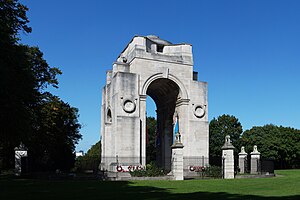
The years after Second World War, particularly from the 1960s onwards, brought many social and economic challenges. There was a steady and irreversible decline in Leicester's traditional manufacturing industries and in the city centre working factories and light industrial premises have now been almost entirely displaced by new businesses. The 1960s and 1970s saw the movement of passengers and freight by rail and barge eclipsed by the growth of road transport. The Great Central Railway and the Leicester and Swannington Railway both closed and the northward extension of the M1 motorway linked Leicester into a growing motorway network. By the 1990s Leicester's central position and its good road transport links to the rest of the country had given it a new strategic importance as a distribution centre and the south western boundaries of the city have attracted many new businesses in both service and manufacturing sectors.
Mass housebuilding continued across Leicester for some 30 years after Second World War ended in 1945. Existing housing estates such as Braunstone were expanded, while several completely new estates - of both private and council tenure - were built. The last major development of this era was Beaumont Leys in the north of the city, which was developed in the 1970s as a mix of private and council housing.
With the loss of much of the city's industry during the 1970s and 1980s, some of the old industrial jobs were replaced by new jobs in the service sector, particularly in retail. The opening of the Haymarket Shopping Centre in 1971 was followed by a number of new shopping centres in the city, including St Martin's Shopping Centre in 1984 and the Shire Shopping Centre in 1992.[3]
Since the war Leicester has experienced large scale immigration from across the world. Immigrant groups today make up around 40% of Leicester's population, making Leicester one of the most ethnically diverse cities in the United Kingdom. Many Polish servicemen were prevented from returning to their homeland after the war by the communist regime, and they established a small community in Leicester. Economic migrants from the Irish Republic continued to arrive throughout the post war period. Immigrants from the Indian sub-continent began to arrive in the 1960s, their numbers boosted by Asians arriving from Kenya and Uganda in the early 1970s.[4][5]
In the 1990s, apparently drawn by the city's free and easy atmosphere and by the number of mosques, a group of Dutch citizens of Somali origin settled in the city. Since the 2004 enlargement of the European Union a significant number of East European migrants have settled in the city. While some wards in the northeast of the city are more than 70% Asian, wards in the west and south are all over 70% white. The Commission for Racial Equality (CRE) estimated that by 2011 Leicester would have approximately a 50% ethnic minority population, making it the first city in Britain not to have a white British majority, a prediction was based on the growth of the ethnic minority populations between 1991 (Census 1991 28% ethnic minority) and 2001 (Census 2001 – 36% ethnic minority). Others have doubted the CRE’s use of statistics.
Geography
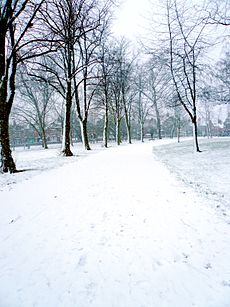
Languages
Alongside English there are around 70 languages and/or dialects spoken in the city. In addition to English, many other languages are commonly spoken: Gujarati is the preferred language of 16% of the city’s residents, Punjabi 3%, Somali 4% and Urdu 2%. Other smaller language groups include Chinese (Cantonese and Mandarin), Hindi, Arabic, Bengali, Malayalam and Polish. With continuing migration into the city, new languages and or dialects from Africa, the Middle East and Eastern Europe are also being spoken in the city.
In primary schools in Leicester, English is not the ‘preferred’ language of 45% of pupils and the proportion of children whose first language is known, or believed to be, other than English, is significantly higher than other cities within the region, or within the United Kingdom.
Sights of the city
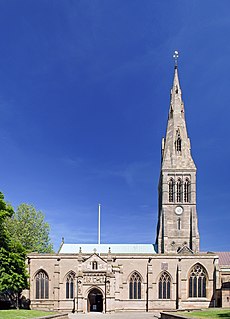
There are ten Scheduled Monuments in Leicester and thirteen Grade I listed buildings: some sites, such as Leicester Castle and the Jewry Wall, appear on both lists.
20th century architecture: Leicester University Engineering Building (James Stirling & James Gowan : Grd II Listed), Kingstone Department Store, Belgrave Gate (Raymond McGrath : Grd II Listed)
Parks: Abbey Park, University of Leicester Botanic Gardens, Castle Gardens, Gorse Hill City Farm, Grand Union Canal, Knighton Park, Nelson Mandela Park, River Soar, Victoria Park, Watermead Country Park.
Industry: Abbey Pumping Station, National Space Centre, Great Central Railway (preserved)|Great Central Railway.
Historic buildings: Town Hall, Guildhall, Belgrave Hall, Jewry Wall, Secular Hall, Abbey, Castle, St Mary de Castro, The City Rooms, Newarke Magazine Gateway.
Shopping: Haymarket Shopping Centre, Highcross, Market, Golden Mile, Fosse Shopping Park, St Martin's Square, Silver Arcade.
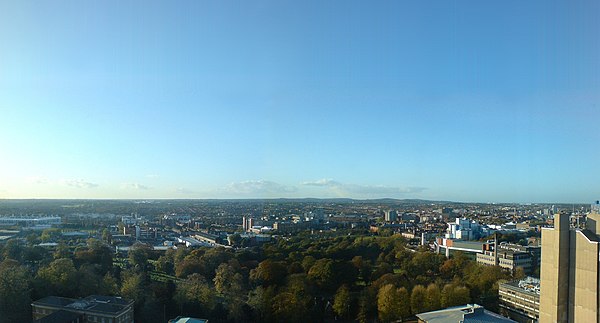
Museums
-
Newarke Houses Museum (Grade II*)
-
New Walk Museum
-
Jewry Wall Museum
-
Belgrave Hall
-
Gas Museum
-
The Guildhall
Local media
Leicester is home to the Leicester Mercury newspaper, and the Midlands Asian Television channel known as MATV Channel 6.
BBC Radio Leicester was the first BBC Local Radio station in Britain, opening on 8 November 1967. Other analogue FM radio stations are Takeover Radio, Heart 106, 106.6 Smooth Radio and Hindu Sanskar Radio, which only broadcasts during Hindu religious festivals. BBC Asian Network and Sabras Radio broadcast on AM.
References
- Notes
- ↑ Geoffrey of Monmouth, The History of the Kings of Britain
- ↑ "1645:The Storming of Leicester and the Battle of Naseby". http://www.british-civil-wars.co.uk/military/1645-leicester-naseby.htm.
- ↑ [1]
- ↑ Leicester's Ugandan Asian success story. Retrieved 2010-11-28.
- ↑ A history of Leicester. Retrieved 2010-11-28.
- Further reading
- Hoskins, W. G. (1957) Leicestershire: an illustrated essay on the history of the landscape. London: Hodder & Stoughton
Outside links
| ("Wikimedia Commons" has material about Leicester) |
- "Leicester Tourist Guide". http://www.goleicestershire.com/.
- "One Leicester". http://www.oneleicester.com/.
- "Leicester City Council". http://www.leicester.gov.uk/.
- "Leicester's Theatre History". http://www.arthurlloyd.co.uk/LeicesterTheatresIndex.htm.
| Cities in the United Kingdom |
|---|
|
Aberdeen • Armagh • Bangor (Caernarfonshire) • Bangor (County Down) • Bath • Belfast • Birmingham • Bradford • Brighton and Hove • Bristol • Cambridge • Canterbury • Cardiff • Carlisle • Chelmsford • Chester • Chichester • Colchester • Coventry • Derby • Doncaster • Dundee • Dunfermline • Durham • Ely • Edinburgh • Exeter • Glasgow • Gloucester • Hereford • Inverness • Kingston upon Hull • Lancaster • Leeds • Leicester • Lichfield • Lincoln • Lisburn • Liverpool • City of London • Londonderry • Manchester • Milton Keynes • Newcastle upon Tyne • Newport • Newry • Norwich • Nottingham • Oxford • Perth • Peterborough • Plymouth • Portsmouth • Preston • Ripon • Rochester • Salford • Salisbury • Sheffield • Southampton • St Albans • St Asaph • St David's • Southend-on-Sea • Stirling • Stoke-on-Trent • Sunderland • Swansea • Truro • Wakefield • Wells • Westminster • Winchester • Wolverhampton • Worcester • Wrexham • York |






